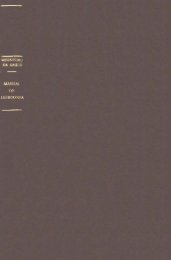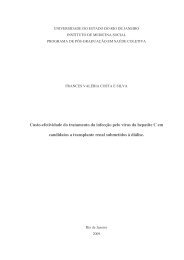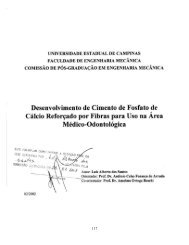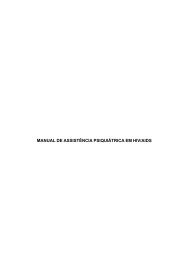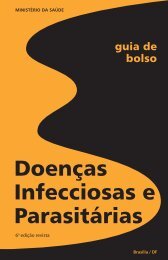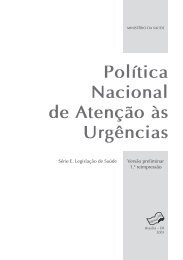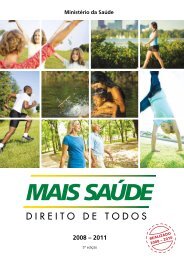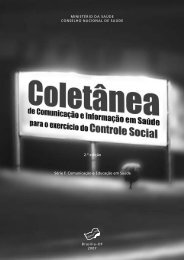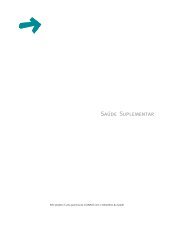Manual de Atenção à Saúde da Criança Indígena Brasileira
Manual de Atenção à Saúde da Criança Indígena Brasileira
Manual de Atenção à Saúde da Criança Indígena Brasileira
You also want an ePaper? Increase the reach of your titles
YUMPU automatically turns print PDFs into web optimized ePapers that Google loves.
Na prática, usam-se alguns índices antropométricos como:<br />
Índice <strong>de</strong> obesi<strong>da</strong><strong>de</strong> (IO) = (Peso (kg)) -1)x 100<br />
Peso i<strong>de</strong>al*<br />
*Marque o ponto correspon<strong>de</strong>nte <strong>à</strong> altura <strong>da</strong> criança. A seguir, trace uma reta passando<br />
pelo valor atual <strong>da</strong> altura <strong>da</strong> criança, até alcançar a curva correspon<strong>de</strong>nte ao percentil<br />
50 <strong>da</strong> altura. A i<strong>da</strong><strong>de</strong> correspon<strong>de</strong>nte a este cruzamento é chama<strong>da</strong> <strong>de</strong> i<strong>da</strong><strong>de</strong>-altura. Verifique,<br />
nesta i<strong>da</strong><strong>de</strong>, qual é o peso, em quilos, correspon<strong>de</strong>nte ao percentil 50. Divi<strong>da</strong> este<br />
valor, aqui chamado <strong>de</strong> “peso i<strong>de</strong>al”, pelo peso atual <strong>da</strong> criança e você obterá o índice <strong>de</strong><br />
obesi<strong>da</strong><strong>de</strong>.<br />
• obesi<strong>da</strong><strong>de</strong> leve = 20%-30%;<br />
• obesi<strong>da</strong><strong>de</strong> mo<strong>de</strong>ra<strong>da</strong> = 30%-50%;<br />
• obesi<strong>da</strong><strong>de</strong> grave => 50%.<br />
Índice <strong>de</strong> Massa Corpórea – IMC (índice <strong>de</strong> Quetelet)= peso (kg)<br />
estatura (m)²<br />
Foram construí<strong>da</strong>s curvas para ambos os sexos com as variações <strong>de</strong> IMC distribuí<strong>da</strong>s<br />
em percentis.<br />
Sobrepeso = índice entre os percentis 85 e 95.<br />
Obesi<strong>da</strong><strong>de</strong> = índice acima do percentil 95.<br />
Qual é o melhor índice para a avaliação <strong>da</strong> obesi<strong>da</strong><strong>de</strong>?<br />
O índice que tem tido aplicação mais difundi<strong>da</strong> e aceito é o Índice <strong>de</strong> Massa Corpórea<br />
e correlaciona o peso (kg) ao quadrado <strong>da</strong> altura (m). Simples <strong>de</strong> obter, <strong>de</strong>scarta a influência<br />
<strong>da</strong> altura no peso e correlaciona-se estreitamente á adiposi<strong>da</strong><strong>de</strong>.<br />
Quais são as conseqüências clínicas <strong>da</strong> obesi<strong>da</strong><strong>de</strong>?<br />
• aumento <strong>da</strong> altura;<br />
• menarca precoce;<br />
• avanço <strong>da</strong> i<strong>da</strong><strong>de</strong> óssea.<br />
Quais são as conseqüências mórbi<strong>da</strong>s <strong>da</strong> obesi<strong>da</strong><strong>de</strong>?<br />
• hiperlipi<strong>de</strong>mia com <strong>de</strong>posição precoce <strong>de</strong> placas <strong>de</strong> ateroma;<br />
• hiperinsulinemia levando precocemente <strong>à</strong> condição <strong>de</strong> diabético;<br />
• hipertensão arterial reversível com a per<strong>da</strong> <strong>de</strong> peso;<br />
<strong>Manual</strong> <strong>de</strong> <strong>Atenção</strong> <strong>à</strong> Saú<strong>de</strong> <strong>da</strong> <strong>Criança</strong> <strong>Indígena</strong> <strong>Brasileira</strong> – pág. 143



